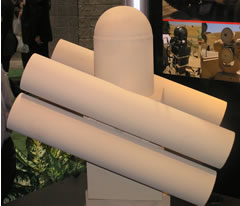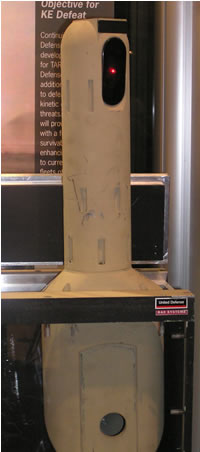 The next step in the US Army Defensive Aid Technology (DAS) is the Army Active Protection System (IAAPS). This is an integrated FCS system uses integrated soft and hard-kill measures, passive (EO) and active (radar) sensors, soft kill countermeasures (IR jammers and decoys) and hard kill active protection system devices. The system is designed to protect an armored vehicle from direct fire and top attack threats with growth potential for Kinetic Energy (KE) threat defeat.
The next step in the US Army Defensive Aid Technology (DAS) is the Army Active Protection System (IAAPS). This is an integrated FCS system uses integrated soft and hard-kill measures, passive (EO) and active (radar) sensors, soft kill countermeasures (IR jammers and decoys) and hard kill active protection system devices. The system is designed to protect an armored vehicle from direct fire and top attack threats with growth potential for Kinetic Energy (KE) threat defeat.  IAAPS is programmed to intercept a threat at a long range, by detecting the launch signature of a missile or gun firing of a tank. After detection, the system attempts to disrupt the missile’s guidance by IR countermeasures, but if such attempts fail, the hard-kill module is erected, detects the incoming target, and traverse to point the countermeasure rockets at the incoming target. A projectile is launched at the direction of the incoming threat, to intercept and destroy it at a distance of 30 meters from the protected vehicle.
IAAPS is programmed to intercept a threat at a long range, by detecting the launch signature of a missile or gun firing of a tank. After detection, the system attempts to disrupt the missile’s guidance by IR countermeasures, but if such attempts fail, the hard-kill module is erected, detects the incoming target, and traverse to point the countermeasure rockets at the incoming target. A projectile is launched at the direction of the incoming threat, to intercept and destroy it at a distance of 30 meters from the protected vehicle.  In February 2003, the U.S. Army’s Tank-automotive and Armaments Command (TACOM) demonstrated the defeat of three new categories of anti-tank threats by such a new Integrated defensive system developed by United Defense Industries. Unlike existing countermeasures, threats were defeated by “soft kill” electronic countermeasures and “hard kill” active protection counter-munitions. The System classifies the inbound threat and assigns the right countermeasure to defeat it. The suite includes two types of passive sensors, electronic warfare countermeasures and an active protection system composed of launcher, radar and a deployed countermeasure. The system demonstrated both “point protection” of the attacked vehicle as well as “area protection” of a limited surrounding area. The suite incorporates an EW system delivered by BAE Systems and an active protection system developed by Northrop Grumman Space Technology, linking to United Defense’s platform survivability processor. A derivative of IAAPS designated CICM, utilizing nun-bursting electrically powered active countermeasures was developed by United Defense in 2004, as a near-term countermeasure against RPG threats encountered in Iraq. IAAPS can handle multiple, simultaneous threats and has already defeated six categories of threats over the past year, puts the system right on track for FCS Block 1. In September 2003, TACOM began a new series of tests that included IAAPS testing on a combat vehicle defeating live threats while traveling at 20 mph. These tests are expected to continue through 2005. Future growth of the IAAPS system includes incorporation of the objective active protection counter-munitions for hardened threats and specifically large caliber long rod penetrators. The Integrated Army Active Protective System (IAAPS) is The Command is developing the following two APS programs for integration into the current force in order to increase survivability of our warfighters.
In February 2003, the U.S. Army’s Tank-automotive and Armaments Command (TACOM) demonstrated the defeat of three new categories of anti-tank threats by such a new Integrated defensive system developed by United Defense Industries. Unlike existing countermeasures, threats were defeated by “soft kill” electronic countermeasures and “hard kill” active protection counter-munitions. The System classifies the inbound threat and assigns the right countermeasure to defeat it. The suite includes two types of passive sensors, electronic warfare countermeasures and an active protection system composed of launcher, radar and a deployed countermeasure. The system demonstrated both “point protection” of the attacked vehicle as well as “area protection” of a limited surrounding area. The suite incorporates an EW system delivered by BAE Systems and an active protection system developed by Northrop Grumman Space Technology, linking to United Defense’s platform survivability processor. A derivative of IAAPS designated CICM, utilizing nun-bursting electrically powered active countermeasures was developed by United Defense in 2004, as a near-term countermeasure against RPG threats encountered in Iraq. IAAPS can handle multiple, simultaneous threats and has already defeated six categories of threats over the past year, puts the system right on track for FCS Block 1. In September 2003, TACOM began a new series of tests that included IAAPS testing on a combat vehicle defeating live threats while traveling at 20 mph. These tests are expected to continue through 2005. Future growth of the IAAPS system includes incorporation of the objective active protection counter-munitions for hardened threats and specifically large caliber long rod penetrators. The Integrated Army Active Protective System (IAAPS) is The Command is developing the following two APS programs for integration into the current force in order to increase survivability of our warfighters.
















